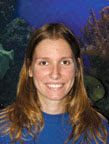
Mellisa is back with some more tales of her time in Honduras. I hope that you enjoyed hearing about her diving adventures. This one is about her experience with the Queen Angel.
Welcome Melissa.
My favorite fish by far while diving in Roatan, Honduras was the Queen Angelfish, Holocanthus cillaris. Every dive we went on I always had my eyes on the look out for a queen. Queen Angelfish are among the most stunning fish in both juvenile and adult stages on the reef.
As far as captive care for a Queen Angelfish they require a large tank due to their large adult size of 15”. Angelfish in general require good water quality and places to hide to feel safe. It is not usually a good idea to house queen angelfish with any other angels unless it is in an extremely large tank, like in a public aquarium with thousands of gallons. This is because they become very territorial in a cramped tank. Juvenile queen angelfish are known to pick parasites from the gills and body of other larger fish. Queen angelfish should be fed a diet high in algae and sponge along with a variety of meaty foods mixed in. Angel Formula is a good staple food for a queen since it is made from marine sponges and algae. Saltwater Vita-Chem is another good product to mix in with the food to make it more nutritious and keep your angle happy and healthy for years to come.
The queen angelfish is also commonly confused with a similar species of angelfish, the Blue Angel Holocanthus bermudensis . Their juvenile colors are very similar but the Queen angel has curved bars where as the Blue Angelfish all fairly straight and vertical. The adult Queen Angelfish has a bright yellow tail and a brilliant blue crown on the top of its head thus making it worthy of the name “Queen” Angelfish.
Anyone interesed in keeping the Queen Angel in their aquarium can also check out this video I helped make: Queen Angel
~Melissa
 That Fish Blog – Aquarium Advice and Information
That Fish Blog – Aquarium Advice and Information


